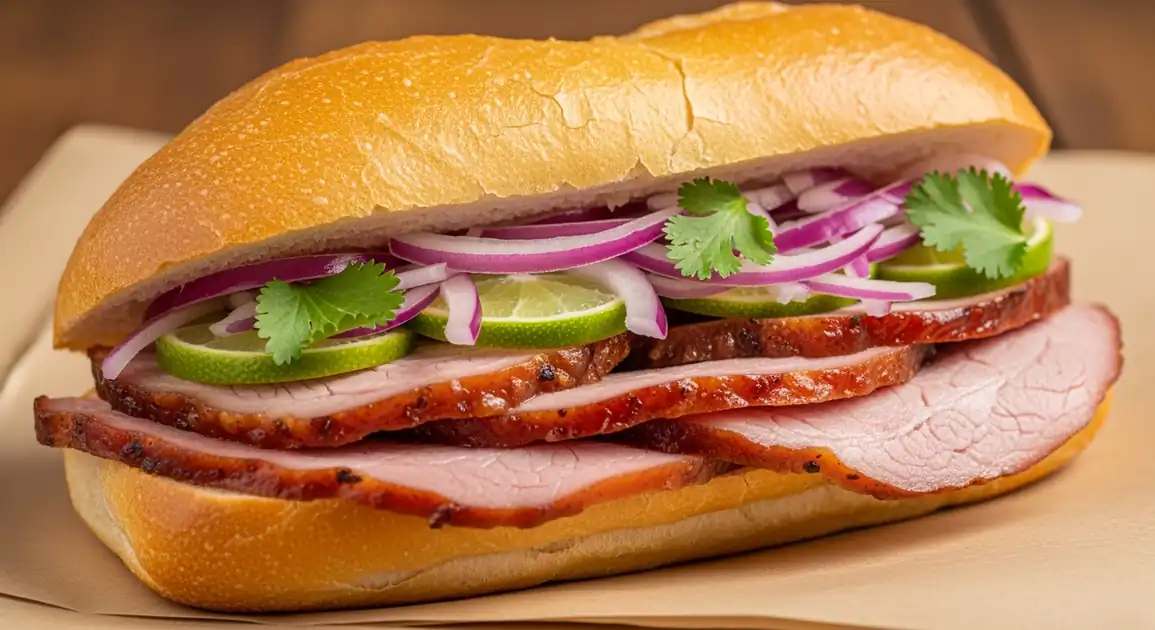Butifarra Sandwich
Sánguche de Butifarra

Description
Butifarra is considered one of Peru's national sandwiches, found throughout the country but most celebrated in coastal areas, particularly Lima. While regional variations exist, the classic combination of jamón del país and salsa criolla remains consistent nationwide. It's primarily a casual, quick meal enjoyed at dedicated sandwich shops (sangucherías), markets, and street stands.
Dietary Information
Serving information
Serving style
Typically served wrapped in paper, sometimes with napkins on the side. Eaten by hand immediately rather than taken to go. Often accompanied by chicha morada (purple corn drink) or a soft drink.
Quick facts
Most sangucherías operate from 8 AM - 8 PM, with peak hours during lunch (12 PM - 3 PM). Market stalls typically open early (7 AM) and close by late afternoon (5 PM - 6 PM).
Safety Tips
What to Look For
-
Ham sliced to order, not pre-sliced sitting out
Freshly sliced meat minimizes exposure to air and potential contamination. Pre-sliced ham sitting at room temperature is a significant risk factor.
-
Visible refrigeration for the ham
Proper cold storage of pork products is essential to prevent bacterial growth. Look for vendors with clear refrigeration systems.
-
Freshly prepared salsa criolla
The onion mixture should look bright and freshly made, not wilted or browned. Fresh criolla indicates attention to quality and food safety.
-
Clean preparation surfaces and utensils
Observe if the vendor maintains separate cutting boards for meat and vegetables, and regularly cleans surfaces.
-
High customer turnover
Popular spots with lines usually have fresher ingredients that don't sit around for long periods.
What to avoid
-
Pre-made sandwiches sitting in displays
Butifarra should be made to order. Pre-assembled sandwiches allow bacteria to multiply, especially if not properly refrigerated.
-
Meat that appears dry, discolored, or has a strong smell
These are signs the ham may be old or improperly stored. Quality jamón del país should be moist and have a fresh appearance.
-
Vendors handling money and food without washing hands or changing gloves
Poor hygiene practices increase cross-contamination risks. Look for vendors who have someone handling money separately or who wash hands/change gloves between tasks.
-
Unrefrigerated meat in warm weather
Especially concerning during Lima's summer months (December-March). Pork products should be kept cool until serving.
-
Salsa criolla that appears wilted or brownish
This indicates it was prepared long ago. The onions should be crisp and white/purple in color with green cilantro.
Price information
Price range
Budget tips
- Basic butifarra at markets or neighborhood spots costs 5-8 PEN.
- Mid-range sangucherías charge 8-12 PEN for quality butifarra.
- Premium versions at upscale establishments can cost 12-20 PEN.
- Prices increase in tourist areas - visit local neighborhoods for better value.
Value indicators
- Generous portions of freshly sliced ham.
- House-made jamón del país rather than commercial versions.
- Freshly baked bread with proper texture.
- Abundant, freshly prepared salsa criolla.
- Proper balance of meat to bread ratio.
Where to Find This Dish
City Markets
Fresh butifarra found at food stalls within traditional markets.
Mercado Central, Regional markets in major cities
Morning, Early Afternoon
Commercial Districts
Dedicated sangucherías in business areas serving workers and shoppers.
Business centers, Shopping areas
Lunch hours (12 PM - 3 PM), Evening
Tourist Areas
Upscale versions catering to visitors, often more expensive.
Miraflores (Lima), Historic centers
Lunch, Dinner
Vendor Tips
- Ask if they make their own jamón del país - house-made is superior.
- Request your sandwich 'recién hecho' (freshly made) to ensure the ingredients are prepared on the spot.
- For proper texture, the bread should be lightly toasted ('tostadito').
How to Order
Regional Variations
-
Classic Butifarra
(Butifarra Clásica)
The traditional version with jamón del país, salsa criolla on pan francés (French roll).
-
Butifarra with Cheese
(Butifarra con Queso)
Adds a slice of mild white cheese (often queso fresco or Swiss) to the classic recipe.
-
Butifarra with Lettuce and Tomato
(Butifarra Completa)
Includes additional fresh vegetables - typically lettuce and tomato slices - for a more substantial sandwich.
-
Gourmet Butifarra
(Butifarra Gourmet)
Upscale versions found in modern sangucherías using artisanal bread, house-cured ham, and additional premium ingredients like avocado or specialized sauces.
-
Spicy Butifarra
(Butifarra Picante)
Topped with hot pepper sauce (ají) or includes hot peppers in the salsa criolla for heat-loving palates.
Cultural context
History
Butifarra's origins trace back to Spanish influence in Peru, specifically Catalan immigrants who brought their 'botifarra' sausage tradition. Over generations, the Peruvian version evolved into the distinct sandwich known today. By the early 20th century, butifarra became firmly established in Lima's culinary landscape, with famous establishments like El Chinito (founded 1957) helping cement its status as a national dish. The sandwich represents Peru's culinary mestizaje (blending), combining European bread and meat preparation with native ingredients and techniques.
Local significance
Butifarra represents Peru's sandwich culture and is considered a national dish. It embodies the Spanish-Creole influence on Peruvian cuisine and is a source of culinary pride.
Eating customs
- Eaten fresh rather than as takeaway when possible.
- Accompanied by chicha morada or Inca Kola.
- Additional lime often added at the table according to personal preference.
- Sometimes paired with 'tamal' (corn tamale) for a more substantial meal.